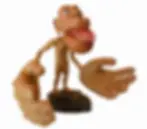Pain That Moves? Understanding Pain Smudging and How to Retrain Your Brain
- Rebecca Brown
- Feb 28
- 5 min read
Have you ever had pain that seemed to have a mind of its own? One day it’s in your lower back, the next it’s creeping into your hip, and suddenly even simple movements feel awkward or unnatural.
Maybe when you explain this to people, they say "it's in your head"—and they’re right. It’s happening inside your brain, and it’s a normal response to chronic pain. It’s called pain smudging, and it’s a fascinating (and frustrating) way your brain responds to persistent pain.

The Brain’s Map: Understanding the Homunculus
Your brain has a built-in map of your body called the homunculus, located in the primary somatosensory cortex. This map determines how your brain perceives sensation and movement in different body parts. But here’s the catch—it’s not evenly distributed.
Think of a cartoon character with huge hands, lips, and feet, but a tiny torso and legs. That’s what the homunculus looks like! These body parts take up more space in the brain because they have a higher density of nerve endings, requiring more sensory input and fine motor control. In contrast, areas like your back or thighs have less representation, which is why they often feel less sensitive to touch.
This sensory map is flexible and adaptable, but it can become distorted over time due to persistent pain, injury, or disuse. When a body part experiences prolonged pain, the brain’s map starts to lose clarity—like a once-sharp photograph that becomes blurry. This is where pain smudging begins.

How Persistent Pain Influences Smudging
Pain doesn’t just affect the body—it reshapes how the brain perceives it. When pain signals are sent repeatedly, the brain adapts by expanding the representation of the painful area. This means the brain’s map of that body part becomes less precise, leading to increased pain sensitivity and a sense that the pain is spreading.
A helpful way to visualise this is with a hand pin box, one of those novelty gadgets filled with hundreds of small pins that take the shape of whatever you press into them. When functioning correctly, pressing your hand into the pins creates a clear, well-defined imprint of your fingers and palm. But if the pins were bent, squished together, or some were missing, the shape would be distorted and blurry. This is exactly what happens when pain smudging occurs—the once-sharp map of your body in your brain becomes fuzzy and imprecise.

How Does Pain Smudging Happen?
Let’s say you’ve had persistent lower back pain. At first, it feels like a small, defined ache in one spot. But over time, things start to change. The pain doesn’t just stay put—it drifts into nearby areas, making your hips, legs, or even the opposite side feel sore. It’s as if your brain is struggling to get a clear picture of where the discomfort is actually coming from, so instead, it starts interpreting signals in a more scattered way, making everything feel more sensitive and harder to pinpoint.
Pain Smudging Affects More Than Just Sensation—It Affects Movement Too
Most people think of smudging as a purely sensory issue, where pain spreads and becomes harder to pinpoint. But new research shows that smudging also impacts motor control—meaning it’s not just about how pain feels, but also how you move.
When pain persists, the brain loses its ability to activate muscles separately, leading to clumsy, stiff, or protective movement patterns. Studies show that people with severe pain experience the worst motor smudging, meaning their brain struggles to control individual back muscles properly. This can create a cycle where poor movement feeds into more pain, reinforcing the problem.
How Does This Affect You?
Pain smudging can lead to frustrating symptoms, including:
Blurry or widespread pain – Instead of being in one precise location, the pain moves or spreads.
Weird sensations – Some people experience tingling, numbness, or sensitivity beyond the original injury.
Referred pain – Your brain misinterprets signals, causing pain in places that aren’t actually injured.
Clumsiness or stiffness – If the brain’s map of a body part is blurred, movement can feel awkward or uncoordinated.
Can We Reverse Smudging? Absolutely!
Since the brain is neuroplastic (meaning it can change and adapt), we can train it to sharpen its body map again. Here are some science-backed strategies:
1. Tactile Discrimination Training
Close your eyes and have someone lightly touch different points on your skin. Try to guess exactly where you were touched. This helps fine-tune the brain’s body map.
2. Mirror Therapy
If one limb is in pain, using a mirror to create the illusion of movement in the pain-free limb can ‘reset’ the brain’s perception of pain.

3. Graded Motor Imagery (GMI)
Picture yourself moving before actually doing it. Studies show that this helps rewire pain responses in the brain.
4. Body Scanning & Mindfulness
Focusing on how different parts of the body feel (without judgement) can help the brain re-learn what is actually happening, rather than relying on faulty pain signals.

5. Progressive Movement Therapy
Moving in small, pain-free ranges helps the brain re-establish a clearer connection with the body, reducing smudging over time.
This Story Might Help
Imagine looking at a map of Australia, but over time, the borders of Queensland, NSW, and Victoria start blending together. If someone asks you to point to exactly where Brisbane is, you might struggle—it’s somewhere in the mix, but it’s not clear. That’s exactly what’s happening in your brain when pain smudging occurs—the borders between body parts blur, and the brain can’t tell what’s what anymore.
Luckily, just as a faded map can be redrawn, so can your brain’s body map!

Pain smudging shows us that pain isn’t just about damaged tissues—it’s about how the brain interprets pain signals. By focusing on retraining the brain, rather than just treating the painful body part, we can improve function, reduce pain, and move more freely.
If you’re struggling with persistent pain and wondering how to retrain your brain, working with an Exercise Physiologist or pain specialist who understands neuroplasticity can be a game-changer.
References:
Massé-Alarie, H., Shraim, M., & Hodges, P. W. (2024). Sensorimotor Integration in Chronic Low Back Pain. Neuroscience, 552, 29–38. https://doi.org/10.1016/j.neuroscience.2024.06.008
Schabrun, S. M., Elgueta-Cancino, E. L., & Hodges, P. W. (2017). Smudging of the Motor Cortex Is Related to the Severity of Low Back Pain. Spine (Philadelphia, Pa. 1976), 42(15), 1172–1178. https://doi.org/10.1097/BRS.0000000000000938
Tsao, H., Danneels, L. A., & Hodges, P. W. (2011). ISSLS prize winner: Smudging the motor brain in young adults with recurrent low back pain. Spine (Philadelphia, Pa. 1976), 36(21), 1721–1727. https://doi.org/10.1097/BRS.0b013e31821c4267


